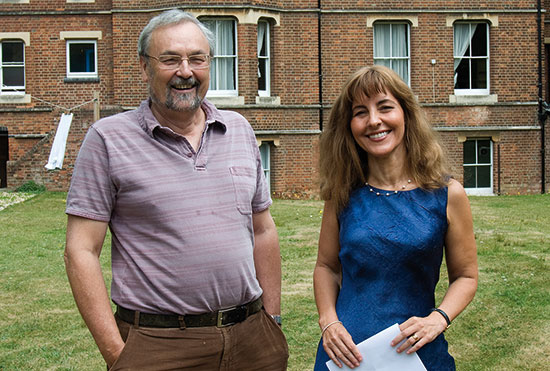Robin Dunbar
How many friends can we have?
Evolutionary Antropology Professor at Oxford University

Robin Dunbar (Liverpool, 1947), professor at the University of Oxford and member of the British Academy, an anthropologist and evolutionary biologist of international renown, is known above all for his discovery that the maximum number of individuals that a human being can have a stable relationship with is 150. His most widely known publications, of which there are many, include: Reproductive Decisions. An Economic Analysis of Gelada Baboon Social Strategies (1984), Primate Social Systems (1988), The Trouble with Science (1996), Grooming, Gossip and the Evolution of Language (1997), Primate Conservation Biology (2000), The Human Story (2004) and How Many Friends Does One Person Need? Dunbar’s Number and Other Evolutionary Quirks (2010).
«Have you come about the experiment?» I was asked on entering the Institute of Cognitive and Evolutionary Anthropology at Oxford, directed by Robin Dunbar. «Which experiment?» They were trying to use an interactive program to measure the tendency of different subjects to obey orders from supernatural beings rather than responding to other humans’ requests. Before I had time to disobey the ghosts, Professor Dunbar arrived on his bike, gasping for breath he apologized for being late and, seeing the cameras, for the untidy state of his office. «Oh no, there’s a skull here, my wife will kill me if she sees this mess in the photos», he said obviously more afraid of the living.
We shot a video for the Great Ape Project webpage dealing with the most important primatological findings over the last twenty years. Then, we went on to talk about his most recent books, The Human Story (2004 –translated into Spanish as La odisea de la humanidad, by Crítica) and How Many Friends Does One Person Need? Dunbar’s Number and Other Evolutionary Quirks, which has just come out.
Darwin said we would learn more about metaphysics by studying baboons than by reading John Locke, and your two latest books, as well as your earlier works, disclose many philosophical concerns. Does this have to do with personality, baboon metaphysics or the link between the work of a primatologist, anthropologist and philosopher?
A bit of everything, I think. I studied philosophy, but then I saw that it was too difficult, so I went into science, just in case I didn’t manage to become a great philosopher [he laughs].
There are many topics that are of interest to all three fields, like the origin of morality…
Yes, we have spent a decade devoted to neuroimaging moral reactions, rejection of unequal distribution among different primates and analyzing the implicit «social contracts» protecting ape communities from scavengers –free-riders– that could destroy them. Human groups are larger, they can reach up to 150 people, which can aggravate the free-rider problem, and makes social and moral norms more necessary.
And how can biology explain moral behaviour in terms of their beneficial effects for the group, when the only acceptable explanations are those bearing on individual reproductive benefits?
We have only recently understood this. Some five or six years ago we began to realise how, in social species, antisocial behaviour may have long-term costs for the individual that outweigh the immediate benefits. If you’re a selfish bully and don’t cooperate, then the others will avoid contact with you and the females will reject you, which will be fatal for your genes.
A simpler example is that of maternal devotion, which undoubtedly improves reproductive success. My theory is that not only moral but perhaps also language and technology are derived from the huge task hominid mothers perform.
Well, that’s possible, because sociability is a female reproductive strategy. They are at the centre of primate sociality. In addition, the brain size of a species increases in line with the female group size of that species and the neocortex is inherited via the maternal genes only, neither the paternal nor from both parents. It is also curious that when the most highly social species, such as bonobos and geladas, are busy eating and cannot groom each other, they connect emotionally using a high-pitched language like motherese or child-directed speech. And Dean Falk links motherese not only to the origin of language, but also to music and art. I had not thought about its possible links to technology, but it may also be the case.
Evolutionary explanations are generally entertained for morality, compassion and reciprocity. But when biologists try to explain our immorality and criminality in Darwinian terms, as in Thornhill and Palmer’s A Natural History of Rape, then there’s an outcry…
Yes, because they confuse the evolutionary explanation with justification and also with a deterministic causal theory, which are two typical misinterpretations of evolutionary explanations. What one has to understand is the extent of the flexibility of human nature, and see how by modifying the costs and benefits derived from certain behavioural patterns, we can change the trade-off.

J. French
Of course, this is what Thornhill and Palmer sought, that the penalty for rape is such that it outweighs the potential benefits. But what if someone kills his children’s mother and then commits suicide? This is the worst thing you could do in terms of passing on your genes. How could this be explained? Perhaps in terms of the indirect benefit of threat with determination?
One theory is that every feature exists in different degrees and there are always extreme cases. There is also the «extreme male brain» theory by the autism expert Simon Baron-Cohen. I’m trying to understand the case of the dreaded Viking beserkers, who were very useful during invasions because they worked themselves up into a fit of rage, ignoring pain or danger and murdering anyone who got in their way, without asking or listening to reason. They were dreaded to such an extent that their family acquired prestige and doubled their chances of survival. It is an example of extreme and threatening behaviour with indirect genetic benefits. Sometimes an entire community united to kill them and, as they murdered for the slightest offence, so began the endless vendettas recounted in the Norse sagas.
Moving from the genocidal psychopath to the international altruist: Do you think the Dunbar number is related to our lack of emotional response to global poverty –more in keeping with the cosmopolitan ethical principles that almost everyone accepts rationally? Are we, by nature, incapable of concerning ourselves much for any more than 150 people, the typical size of a tribe?
The emotive connection certainly declines after that number. It is a limitation of our brain. Nowadays we no longer live in a tribe or village of 150 inhabitants, but in parts of different communities, which may help us stop seeing everything in terms of «them» and «us». But we still have some skills limited to a maximum of 150 people, with whom we know how to behave. We must label the rest in order to guide our behaviour, for instance, priest…
student…
Well [he laughs], we don’t have a clue about their personal circumstances, but labelling them as «students» we already know how to behave towards them.
So, what has Facebook changed? Can it connect, for example, our different communities?
It mainly saves time and effort in terms of memory, but doesn’t actually increase our capacity to feel friendship. In fact Facebook has confirmed that human virtual tribes continue being under 150, between 120 and 130. Some guys have 300 contacts because unlike girls, who keep up their lifelong friendships, they use Facebook to compete, to boast popularity. You know, a girl is all upset because Susie didn’t invite her to the party, but a boy doesn’t care whether his ball bounced off another kid or off the wall –so long as the ball bounced back. [He laughs] We just did a study on how friendships lapse over the years, in contrast to everlasting family relationships, and found that women keep up their relationships by talking while men need to do something together. Men’s phone calls are very short, just calling to set something up.
But your book The Human Story: A New History of Mankind’s Evolution ignores gender differences, presenting an almost asexual account –rather odd for a primatologist, even if he is more or less English (Dunbar left Liverpool when he was three months old and was brought up in Australia and East Africa).
[He laughs] Yes, and even knowing, as we do now, not only that that the neocortex (intelligence) is inherited from our mothers, but that the limbic system (emotional) is inherited from our fathers –just as Aristotle speculated around 350 BC. Men are emotional creatures; women are the thinkers. This is in line with what we mentioned earlier: females are the centre of society. Men are like bees around honey, all they do is lurk around waiting for the chance to mate. And this system selects males that are like berserkers: they act first, think later, they leap onto the females, or fly at others, without hesitation. It would be a disaster if they stopped to say, «Well, let’s take turns, shall we? You copulate first and then I’ll have a go». That way they’d lose the evolutionary race.
And how does religion help you win that race? I’m intrigued by the explanation because one can easily see the origins of humour, language, technology, theory of mind and even aesthetic appreciation in other apes. We’ve seen them talking about death in sign language, burying their dead, visiting the burial place, staying with the dying during their struggle to stay alive, allowing a mother who lost a son to carry its mummified corpse around, even though they are afraid of being touched by a corpse… but we haven’t seen anything akin to religion. Could the idea of the existence of terrible beings be culturally transmitted, and playing with dolls or totems, attributing personalities and intentions to inanimate objects, but knowing it’s just a game?
Yes, only humans attribute these powers on a permanent basis…
What if we placed a large mechanical chimpanzee inside an ape’s cage, which gave him fruit if he begged for it? They are good at asking insistently, so they would implore, crossing themselves if they found it worked. And on seeing others crossing themselves, they would know what the others were trying to do and would do it together, if asking all together were more effective. And the ones that had greater influence with the furry Buddha would acquire a higher rank, and access to females…
Yes, but they wouldn’t imagine a parallel universe where this Buddha lived, without anyone being able to see it. They might come to believe that the hairy Buddha controlled the resources, but would see it as just another ape. This is also true of humans to a certain extent. When we think about what God will do or want, exactly the same part of the brain is activated as when we think about what Johnny will do or want. But monkeys don’t go into a trance, which is central to the most primitive religions, like the shaman, who go into a trance through frenzied dancing, singing…
…taking hallucinogens…
Just so, which makes them participate in the party and all 150 forgive each other and feel united.
Like the classic explanation of the Hopi rain dance, which is no good for making it rain, but helps create cohesion…
Yes, but also a collective imaginary encounter with our ancestors is a highly emotive experience, and triggers endorphin production. This is also the effect of laughter, chatting, singing and dancing, which are all forms of collective grooming without physical contact. But these solutions don’t work well in large groups so collective rituals are required for groups of 150 plus, producing a connector effect and acting as generator of endorphins and social cohesion.

Again we return to the magic number and an asexual and group-centred explanation that doesn’t take us back to individual reproductive advantage, but rather to collective wellbeing However, humour, which relaxes, unites and reconciles, is noticeably missing from religions. Many religions repress and rebuke humour as well as physical contact and dance. By contrast, religious leaders’ control of sexuality and right to sex as they please is a persistent feature of the most diverse religions and sects worldwide, ranging from Trokosi ritual servitude (in which he who claims to speak to the gods can take any girl he pleases and have up to 100 sexual and agricultural slaves) to the nymphs, sexual and domestic slaves of monks from so many countries, to the prostitutes of the temples, the many sects described in The Human Story, and the sex scandals that constantly appear in the press… And it all fits in with the standard biological explanation of male behaviour: power and control of sexuality and of women…
In the Middle Ages alone the variety of sects that arose around sex is amazing. Even within the Christian tradition there were many cults, almost always founded by one man, which started with groups of 50 or 150. Primitive trance-based religions, which after the Neolithic settlement developed hierarchies, theologies and external repressive forces capable of controlling conflicts in ever larger settlements, always came up against these new cults springing up, each with its own rules. And they fought against each other in wars, reprisals, inquisitions and with new even stricter rules. Thus, moral norms, which originally had a social and adaptive basis, were replaced by the rules set down by new sects and religions. A study of North American utopian cults in the nineteenth century by Richard Sosis, University of Connecticut, showed that, in fact, the more prohibitions a cult imposed, the longer it lasted. For example, if it only forbade swearing, it didn’t even last ten years, if alcohol was also prohibited, it lasted twenty, and if it also forbade eating meat and having a mate, it lasted a century [he laughs].
The faithful would have nowhere to go, without a mate, or any friends…
Nor any children to defend, because only the leader could have sex and, therefore, children. Usually the leader is a charismatic man who appeals to many women, for whatever reason…
In many species where males represent more of a threat than a help, females prefer a smaller part of a higher status male than a larger part of a lower status male.
This is the framework of polygamy, which is typical of the Anabaptists, Mormons and many others who exploit the great emotional power religions have over people for this purpose. This power is greater when there are strict rules regarding the distance you must keep from others. This prevents us from combing and grooming each other like other primates. However, like all primates, we need closeness and contact with our fellows, so, feeling united and supported, we secrete endorphins that help us relax, stimulate our immune system and make us feel good. When mutual grooming is forbidden the need for «grooming» without physical contact increases, like singing together or participating in other religious rituals. And people often ask me –and I also wonder– how we could obtain the benefits of physical and mental health that religion seems to provide, without the disadvantages of violence and abuse of power…?
Well, I have survived the physical and social coldness of numerous countries thanks to dancing Salsa. You do exercise, and make friends, you’re part of a group that always seems glad to see you, and you disconnect more easily than meditating, because you have to concentrate on the steps and count them like a mantra. I think the English national health system could save a lot by encouraging Salsa, which doesn’t have the stigma attached to counselling services…
What’s more Salsa is neither hierarchical nor authoritarian, but democratic. There you have it, the solution is to be found in the Salsa casinos.
I don’t know whether Dunbar would have been a great philosopher. He is most certainly an interesting scientist, bursting with information, ideas and questions and his sense of humour is catching. Also his ability to decipher the most diverse phenomena, from the size of the neocortex to religious rituals, even the use of Facebook, with a single number, is a fascinating example of scientific parsimony.





